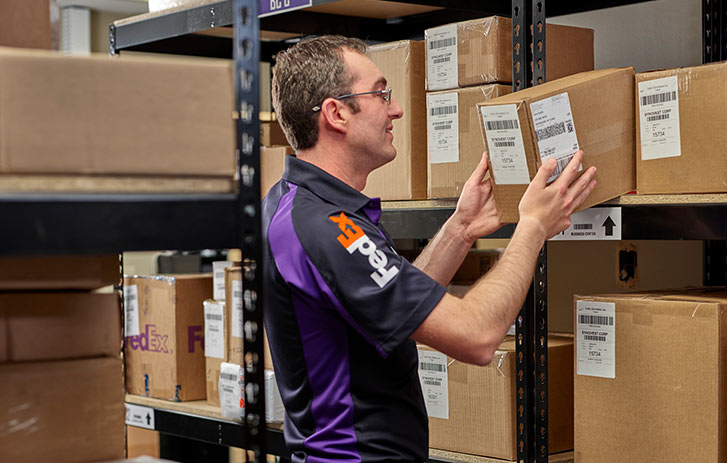Four tips to improve e-commerce inventory management
Refine your inventory management with these tips
Forty-three percent of small businesses don’t track inventory at all.1 Not managing inventory is problematic, but assuming automatic inventory control software can do the job alone may be more dangerous. If you don’t have a person counting and checking the data that goes into your software, you’ll get poor data that can lead to out-of-stock and overstock problems.
- Set a Periodic Automatic Replenishment (PAR) level. A PAR level is the minimum quantity of products to have on hand. Some inventory management software will automatically trigger a reorder when a product is sold down to the PAR level. PAR levels should be set based on sales history and whether you are in or approaching your peak sales season. You’ll want to evaluate your PAR levels several times a year.
- Use First In, First Out (FIFO) rules. These rules are most helpful for perishable items, such as dairy products, fruits, vegetables, wine, etc. They ensure the oldest stock is sent out first. But they’re also helpful for non-perishable items. You don’t want to fulfill orders with dusty boxes or out-of-date packaging.
- See if Just-In-Time (JIT) inventory is right for you. You keep only enough inventory on hand for current orders. Many small businesses use JIT inventory management to control costs, and it’s a great choice if you have limited space for inventory. To make JIT effective, though, you must monitor suppliers and orders closely. You'll also need to know exactly how long it takes to replenish your inventory. JIT is also helpful for a drop shipping model of fulfillment. You don’t keep products in inventory. You pass the orders on to the manufacturer, and they ship directly to the customer. It also works with handmade items, like on Etsy. You make the item once it's ordered. But keep in mind, while shoppers are willing to wait for customized items, they generally are not willing to wait extra days for ready-made items.
Pick the right inventory management software.
You’ll want software that includes:1
- Programmable min/max Periodic Automatic Replenishment (PAR) levels
- Low inventory and reorder alerts
- Automated reordering
- Cross-channel inventory sync
- Just-In-Time inventory management
- Interfaces for point of sale and mobile scanning
- BIN IDs and pick lists
- Multi-warehouse/multi-site inventory tracking
It’s possible that your inventory management software may be built into your e-commerce platform.
1. Put someone in charge
Forty-three percent of small businesses don’t track inventory at all.1 Not managing inventory is problematic, but assuming automatic inventory control software can do the job alone may be more dangerous. If you don’t have a person counting and checking the data that goes into your software, you’ll get poor data that can lead to out-of-stock and overstock problems.
2. Consider different ways to manage your inventory levels
- Set a Periodic Automatic Replenishment (PAR) level. A PAR level is the minimum quantity of products to have on hand. Some inventory management software will automatically trigger a reorder when a product is sold down to the PAR level. PAR levels should be set based on sales history and whether you are in or approaching your peak sales season. You’ll want to evaluate your PAR levels several times a year.
- Use First In, First Out (FIFO) rules. These rules are most helpful for perishable items, such as dairy products, fruits, vegetables, wine, etc. They ensure the oldest stock is sent out first. But they’re also helpful for non-perishable items. You don’t want to fulfill orders with dusty boxes or out-of-date packaging.
- See if Just-In-Time (JIT) inventory is right for you. You keep only enough inventory on hand for current orders. Many small businesses use JIT inventory management to control costs, and it’s a great choice if you have limited space for inventory. To make JIT effective, though, you must know exactly how long it takes to replenish your inventory. You'll also need to manage orders and suppliers closely. JIT is also helpful for a drop shipping model of fulfillment. You don’t keep products in inventory. You pass the orders on to the manufacturer, and they ship directly to the customer. It also works with handmade items, like on Etsy. You make the item once it's ordered. But keep in mind, while shoppers are willing to wait for customized items, they generally are not willing to wait extra days for ready-made items.
3. Pick the right inventory management software
You’ll want software that includes:1
- Programmable min/max Periodic Automatic Replenishment (PAR) levels
- Low inventory and reorder alerts
- Automated reordering
- Cross-channel inventory sync
- Just-In-Time inventory management
- Interfaces for point of sale and mobile scanning
- BIN IDs and pick lists
- Multi-warehouse/multi-site inventory tracking
It’s possible that your inventory management software may be built into your e-commerce platform.
4. Do regular inventory audits
43% of small businesses don’t track inventory at all.1 As much as not managing inventory is problematic, assuming automatic inventory control software can do the job alone is even more dangerous. If you don’t have a person counting and checking the data that goes into your software, you’ll get poor data that can lead to out-of-stock and overstock problems.
- Set a Periodic Automatic Replenishment (PAR) level. A PAR level is the minimum quantity of products to have on hand. Some inventory management software will automatically trigger a reorder when a product is sold down to the PAR level. PAR levels should be set based on sales history and whether you are in or approaching your peak sales season. You’ll want to evaluate your PAR levels several times a year.
- Use First In, First Out (FIFO) rules. These rules are most helpful for perishable items, such as dairy products, fruits, vegetables, wine, etc. They ensure the oldest stock is sent out first. But they’re also helpful for non-perishable items. You don’t want to fulfill orders with dusty boxes or out-of-date packaging.
- See if Just-In-Time (JIT) inventory is right for you. You keep only enough inventory on hand for current orders. Many small businesses use JIT inventory management to control costs, and it’s a great choice if you have limited space for inventory. To make JIT effective, though, you must monitor suppliers and orders closely. You'll also need to know exactly how long it takes to replenish your inventory.
JIT is also helpful for a drop shipping model of fulfillment. You don’t keep products in inventory. You pass the orders on to the manufacturer, and they ship directly to the customer. It also works with handmade items, like on Etsy. You make the item once it's ordered. But keep in mind, while shoppers are willing to wait for customized items, they generally are not willing to wait extra days for ready-made items.
You’ll want software that includes:1
- Programmable min/max Periodic Automatic Replenishment (PAR) levels
- Low inventory and reorder alerts
- Automated reordering
- Cross-channel inventory sync
- Just-In-Time inventory management
- Interfaces for point of sale and mobile scanning
- BIN IDs and pick lists
- Multi-warehouse/multi-site inventory tracking
It’s possible that your inventory management software may be built into your e-commerce platform.
Get help for your small business
Chat with a FedEx expert, request a phone consultation, get how-to guides, and more. Get help now.
Related reading

How to optimize order fulfillment
Learn the goals for optimizing your order fulfillment and the six steps to assess your current fulfillment process.
Read more
4 ways to improve inventory management
Get tips for managing your inventory and fulfillment process. Explore inventory software and how to set inventory levels.
Read article
Should you sell abroad?
If you’re only selling in the US, you’re missing out on a lot of potential customers. But selling internationally comes with challenges.
Read article1 Source: Logiwa